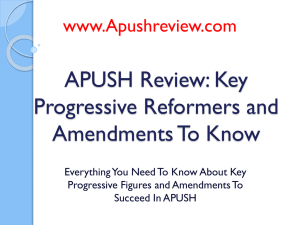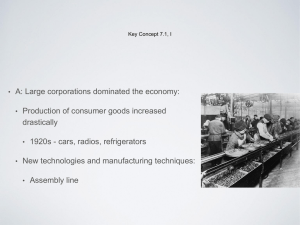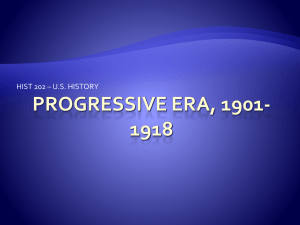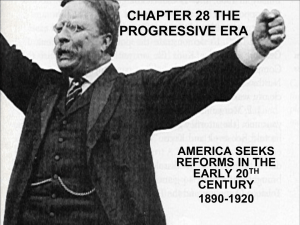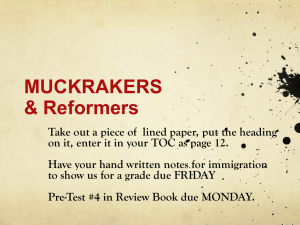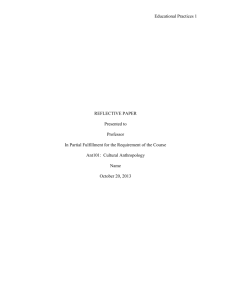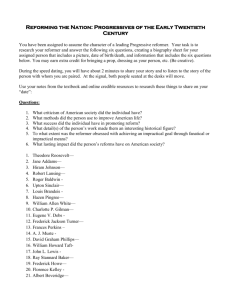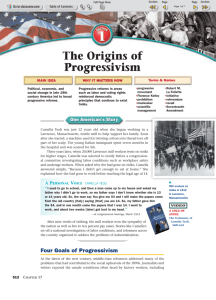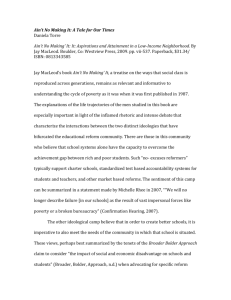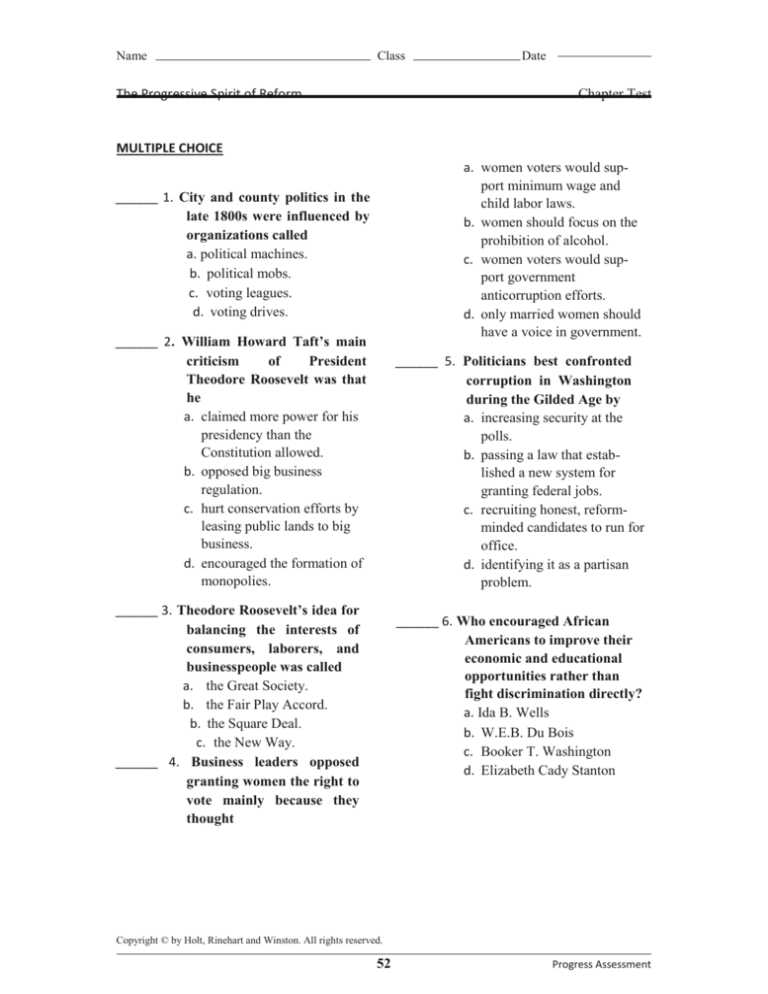
Name
Class
The Progressive Spirit of Reform
Date
Chapter Test
MULTIPLE CHOICE
a. women voters would support minimum wage and
child labor laws.
b. women should focus on the
prohibition of alcohol.
c. women voters would support government
anticorruption efforts.
d. only married women should
have a voice in government.
______ 1. City and county politics in the
late 1800s were influenced by
organizations called
a. political machines.
b. political mobs.
c. voting leagues.
d. voting drives.
______ 2. William Howard Taft’s main
criticism
of
President
Theodore Roosevelt was that
he
a. claimed more power for his
presidency than the
Constitution allowed.
b. opposed big business
regulation.
c. hurt conservation efforts by
leasing public lands to big
business.
d. encouraged the formation of
monopolies.
______ 5. Politicians best confronted
corruption in Washington
during the Gilded Age by
a. increasing security at the
polls.
b. passing a law that established a new system for
granting federal jobs.
c. recruiting honest, reformminded candidates to run for
office.
d. identifying it as a partisan
problem.
______ 3. Theodore Roosevelt’s idea for
balancing the interests of
consumers, laborers, and
businesspeople was called
a. the Great Society.
b. the Fair Play Accord.
b. the Square Deal.
c. the New Way.
______ 4. Business leaders opposed
granting women the right to
vote mainly because they
thought
______ 6. Who encouraged African
Americans to improve their
economic and educational
opportunities rather than
fight discrimination directly?
a. Ida B. Wells
b. W.E.B. Du Bois
c. Booker T. Washington
d. Elizabeth Cady Stanton
Copyright © by Holt, Rinehart and Winston. All rights reserved.
52
Progress Assessment
Name
Class
Chapter Test Form A
The Progressive Spirit of Reform, continued
______
Date
b. poor families needed the
income, however little.
c. corruption made government monitoring useless.
d. the courts established high
child wage rates.
7.
Which statement best
describes the result of
workplace laws passed
during the Progressive
movement?
a. increased trust between labor
and big business
b. eased reformers’ minds
but were not always
enforced
c. caused big business to take
operations abroad
d. led to decreased government interference in the
economy
______ 1 0. What was the main reason for
the rise in Mexican
immigration between 1901
and 1930?
a. Mexicans could cross the
U.S. border with relative
ease.
b. Mexicans became a key part
of the Southwest economy.
c. Mexicans could occupy areas
that once belonged to
Mexico.
d. Mexicans immigrated with
their children and extended
families.
______ 8. Journalists who wrote about
problems in society during
the Progressive age were
known as
a. Progressives.
b. reformers.
c. muckrakers.
d. capitalists.
______ 11. Which of these reforms
allowed voters to overrule a
law that government had
proposed or passed?
a. the recall
b. direct primary
c. the initiative
d. the referendum
______ 9. Child labor continued even
after the reforms of the early
1900s because
a. greedy factory owners lied
about workers’ ages.
FILL IN THE BLANK Read each sentence and fill in the blank with the term that
best completes the sentence. (First term is A, Second term is B)
12. In its first decade, the
brought attention to racial
inequality by using the courts to fight grandfather clauses that had been used to prevent
African Americans in the South from voting. (National Association for the
Advancement of Colored People///National Urban League)
Copyright © by Holt, Rinehart and Winston. All rights reserved.
53
Progress Assessment
Name
Class
Date
Chapter Test Form A
The Progressive Spirit of Reform, continued
13.During the Gilded Age, American reformers called for an end to
, the practice of giving government jobs to supporters
after a candidate wins an election. (civil service///the spoils system)
14. A union member might have claimed that
was unfair
because its emphasis on competition caused managers to consider profits more
important than safe working conditions. (capitalism///socialism)
15. The
Amendment helped expand voting rights by allowing
voters, and not state legislatures, to elect senators.
(Seventeenth///Eighteenth)
TRUE/FALSE Indicate whether each statement below is TRUE or FALSE. True is A
and False is B.
______ 16. To help the conservation movement, Theodore Roosevelt made sure that the
nation uses its natural resources efficiently.
______ 17. The Triangle Shirtwaist Factory fire and other accidents led to passage of laws
improving factory safety.
______ 18. Progressive reforms improved education for medical professionals.
______ 19. A procedure called an initiative allows voters to propose new laws by using
petitions.
______ 20. Workers’ compensation laws prohibited companies from paying wages to
employees injured on the job.
______ 21. In the fight against discrimination, Ida B. Wells drew attention to the lynching of
African Americans.
Please read the paragraph below and answer the questions accordingly:
Failures of Reform
Other minority groups felt left behind by the Progressive movement. Although some
reformers tried to aid such groups, the aim of many was to encourage other ethnicities to
adopt the ways of European society. The Society of American Indians, formed in 1911, was
one such attempt. Started by Native American doctors Carlos Montezuma and Charles
Eastman, the society believed that integration into white society would end Native American
poverty. Many Native Americans, however, wanted to preserve their traditional culture. They
resisted the movement toward adopting white culture.
Copyright © by Holt, Rinehart and Winston. All rights reserved.
54
Progress Assessment
Name
Class
Date
Chapter Test Form A
The Progressive Spirit of Reform, continued
22) Context Clues: The word INTEGRATION most closely means:
1) Mixing
2) Not belong
3) Indifferent
23) Central Idea: The main idea of the passage above would be:
1) Native American groups wanted at all cost to integrate into European society.
2) Many reformers felt it would be in the best interest of Native American groups to
integrate into the ways of a European Society
3) Native Americans felt there was no need to integrate into European society.
24) Citing Evidence: Which evidence in this text would best support the resistance of Native
American culture towards embracing European society.
1) “Although some reformers tried to aid such groups, the aim of many was to
encourage other ethnicities to adopt the ways of European society”
2) “Many Native Americans, however, wanted to preserve their traditional culture”
3) “Started by Native American doctors Carlos Montezuma and Charles Eastman, the
society believed that integration into white society would end Native American
poverty”
25) Evidence Analysis: According to the evidence: “Although some reformers tried to aid
such groups, the aim of many was to encourage other ethnicities to adopt the ways of
European society”
1) Reformers often felt that the way to help minority groups was to make sure that they
adopt the European ways rather than having Europeans embrace and accept their
cultures and traditions.
2) Many reformers tried to help minority groups
3) Many reformers wanted to help minority groups but these groups had to assimilate to
European culture.
Copyright © by Holt, Rinehart and Winston. All rights reserved.
55
Progress Assessment


